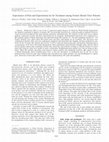Papers by Richard O Phillips
Journal of Hepatology, Apr 1, 2015
the experienced raters was found to be 0.48 with a novice rater ICC of 0.48 as well. The ICC betw... more the experienced raters was found to be 0.48 with a novice rater ICC of 0.48 as well. The ICC between all the raters was 0.33. This constitutes poor reliability. The poor reliability of the technique testing the length of LD was identified and addressed in order for adequate usage thereof, in research and in practice. Recommendations of a new technique to test the length of LD were provided by the researcher. A suggestion was made regarding a manner of testing its reliability. Implications: A reliable technique for assessing the length of the Latissimus Dorsi muscle will add to objectivity and consistency in the assessment as well as the management of human movement related musculo-skelatal conditions.

PLOS Neglected Tropical Diseases, Mar 3, 2021
Buruli ulcer (BU) is a disabling and stigmatising neglected tropical disease (NTD). Its distribut... more Buruli ulcer (BU) is a disabling and stigmatising neglected tropical disease (NTD). Its distribution and burden are unknown because of underdiagnosis and underreporting. It is caused by Mycobacterium ulcerans, an environmental pathogen whose environmental niche and transmission routes are not fully understood. The main control strategy is active surveillance to promote early treatment and thus limit morbidity, but these activities are mostly restricted to well-known endemic areas. A better understanding of environmental suitability for the bacterium and disease could inform targeted surveillance, and advance understanding of the ecology and burden of BU. We used previously compiled point-level datasets of BU and M. ulcerans occurrence, evidence for BU occurrence within national and sub-national areas, and a suite of relevant environmental covariates in a distribution modelling framework. We fitted relationships between BU and M. ulcerans occurrence and environmental predictors by applying regression and machine learning based algorithms, combined in an ensemble model to characterise the optimal ecological niche for the disease and bacterium across Africa at a resolution of 5km x 5km. Proximity to waterbodies was the strongest predictor of suitability for BU, followed potential evapotranspiration. The strongest predictors of suitability for M. ulcerans were deforestation and potential evapotranspiration. We identified patchy foci of suitability throughout West and Central Africa, including areas with no previous evidence of the disease. Predicted suitability for M. ulcerans was wider but overlapping with that of BU. The estimated population living in areas predicted suitable for the bacterium and disease was 46.1 million. These maps could be used to inform burden estimations and case searches which would generate a more complete understanding of the spatial distribution of BU in Africa, and may guide control programmes to identify cases beyond the well-known endemic areas.
Clinical and Vaccine Immunology, 2009
PLOS Neglected Tropical Diseases, Feb 21, 2013
<p>A. MS analysis of ASL from Mu infected human skin showing a molecule with m/z 765.5 whic... more <p>A. MS analysis of ASL from Mu infected human skin showing a molecule with m/z 765.5 which represents the sodium adduct of mycolactone A/B [M+Na<sup>+</sup>]. B. MS-MS analysis of this ion produced the core lactone ring of mycolactone with m/z 429.4 and the polyketide side chain of mycolactone A/B with m/z 359.2.</p

Open Forum Infectious Diseases
BackgroundCoagulopathy is common in acute symptomatic Plasmodium falciparum malaria, and the degr... more BackgroundCoagulopathy is common in acute symptomatic Plasmodium falciparum malaria, and the degree of coagulation abnormality correlates with parasitemia and disease severity. Chronic asymptomatic malaria has been associated with increased morbidity. However, the role of coagulation activation in asymptomatic, semi-immune individuals remains unclear. This study investigates the potential effect of asymptomatic P falciparum infection on coagulation activation in semi-immune Ghanaian adults.MethodsBlood from asymptomatic Ghanaian adults with P falciparum blood stage infection detectable by polymerase chain reaction (PCR) or by both PCR and rapid diagnostic test and from noninfected individuals, was investigated. Markers of coagulation activation including global coagulation tests, D-dimer, antithrombin III, fibrinogen, and von Willebrand factor antigen were tested. Furthermore, blood count, inflammation markers, and liver and kidney function tests were assessed.ResultsAcquired coagul...
Bulletin of The World Health Organization, Oct 1, 2005

PLOS Neglected Tropical Diseases, 2020
Background There is a dearth of data on scabies from Ghana. In September 2019, local health autho... more Background There is a dearth of data on scabies from Ghana. In September 2019, local health authorities in the East Mamprusi district of northern Ghana received reports of scabies from many parts of the district. Due to on-going reports of more cases, an assessment team visited the communities to assess the effect of the earlier individual treatment on the outbreak. The assessment team furthermore aimed to contribute to the data on scabies burden in Ghana and to demonstrate the use of the International Alliance for the Control of Scabies (IACS) diagnostic tool in a field survey in a resource limited setting. Methodology/Principal findings This was a cross sectional study. Demographic information and medical history was collected on all participants using a REDCap questionnaire. A standardised skin examination of exposed regions of the body was performed on all participants. Scabies was diagnosed based on the criteria of the International Alliance for the Control of Scabies (IACS). P...
SSRN Electronic Journal, 2019

BackgroundBuruli ulcer (BU) is a disabling and stigmatising neglected tropical disease (NTD). Its... more BackgroundBuruli ulcer (BU) is a disabling and stigmatising neglected tropical disease (NTD). Its distribution and burden are unknown because of underdiagnosis and underreporting. It is caused by Mycobacterium ulcerans, an environmental pathogen whose environmental niche and transmission routes are not fully understood. Active BU case searches can limit morbidity by identifying cases and linking them to treatment, but these are mostly restricted to well-known endemic areas. A better understanding of environmental suitability for environmental reservoirs of M. ulcerans and BU disease would advance understanding of the disease’s ecology and burden, and could inform targeted surveillance.Methodology/Principal FindingsWe used previously compiled point-level datasets of BU and M. ulcerans occurrence, evidence for BU occurrence within national and sub-national areas, and diverse environmental datasets. We fitted relationships between BU and M. ulcerans occurrence and environmental predict...

PLOS Neglected Tropical Diseases, 2019
Background Access to an accurate diagnostic test for Buruli ulcer (BU) is a research priority acc... more Background Access to an accurate diagnostic test for Buruli ulcer (BU) is a research priority according to the World Health Organization. Nucleic acid amplification of insertion sequence IS2404 by polymerase chain reaction (PCR) is the most sensitive and specific method to detect Mycobacterium ulcerans (M. ulcerans), the causative agent of BU. However, PCR is not always available in endemic communities in Africa due to its cost and technological sophistication. Isothermal DNA amplification systems such as the recombinase polymerase amplification (RPA) have emerged as a molecular diagnostic tool with similar accuracy to PCR but having the advantage of amplifying a template DNA at a constant lower temperature in a shorter time. The aim of this study was to develop RPA for the detection of M. ulcerans and evaluate its use in Buruli ulcer disease. Methodology and principal findings A specific fragment of IS2404 of M. ulcerans was amplified within 15 minutes at a constant 42˚C using RPA method. The detection limit was 45 copies of IS2404 molecular DNA standard per reaction. The assay was highly specific as all 7 strains of M. ulcerans tested were detected, and no cross reactivity was observed to other mycobacteria or clinically relevant bacteria species. The clinical performance of the M. ulcerans (Mu-RPA) assay was evaluated using DNA extracted from fine needle aspirates or swabs taken from 67 patients in whom BU was suspected and 12 patients with clinically confirmed non-BU lesions. All results were compared to a highly sensitive real-time PCR. The clinical specificity of the Mu-RPA assay was 100% (95% CI, 84-100), whiles the sensitivity was 88% (95% CI, 77-95).

The Lancet Global Health, 2019
Background Buruli ulcer can cause disfigurement and long-term loss of function. It is underdiagno... more Background Buruli ulcer can cause disfigurement and long-term loss of function. It is underdiagnosed and underreported, and its current distribution is unclear. We aimed to synthesise and evaluate data on Buruli ulcer prevalence and distribution. Methods We did a systematic review of Buruli ulcer prevalence and used an evidence consensus framework to describe and evaluate evidence for Buruli ulcer distribution worldwide. We searched PubMed and Web of Science databases from inception to Aug 6, 2018, for records of Buruli ulcer and Mycobacterium ulcerans detection, with no limits on study type, publication date, participant population, or location. English, French, and Spanish language publications were included. We included population-based surveys presenting Buruli ulcer prevalence estimates, or data that allowed prevalence to be estimated, in the systematic review. We extracted geographical data on the occurrence of Buruli ulcer cases and M ulcerans detection from studies of any type for the evidence consensus framework; articles that did not report original data were excluded. For the main analysis, we extracted prevalence estimates from included surveys and calculated 95% CIs using Byar's method. We included occurrence records, reports to WHO and the Global Infectious Diseases and Epidemiology Network, and surveillance data from Buruli ulcer control programmes in the evidence consensus framework to grade the strength of evidence for Buruli ulcer endemicity. This study is registered with PROSPERO, number CRD42018116260. Findings 2763 titles met the search criteria. We extracted prevalence estimates from ten studies and occurrence data from 208 studies and five unpublished surveillance datasets. Prevalence estimates within study areas ranged from 3•2 (95% CI 3•1-3•3) cases per 10 000 population in Côte d'Ivoire to 26•9 (23•5-30•7) cases per 10 000 population in Benin. There was evidence of Buruli ulcer in 32 countries and consensus on presence in 12. Interpretation The global distribution of Buruli ulcer is uncertain and potentially wider than currently recognised. Our findings represent the strongest available evidence on Buruli ulcer distribution so far and have many potential applications, from directing surveillance activities to informing burden estimates. Funding AIM Initiative.

PLOS Neglected Tropical Diseases, 2019
Background Buruli Ulcer (BU) is a neglected tropical disease caused by Mycobacterium ulcerans. Fo... more Background Buruli Ulcer (BU) is a neglected tropical disease caused by Mycobacterium ulcerans. Former BU patients may experience participation restrictions due to physical limitations, stigmatization and other social factors. A scale that measures participation restrictions among children, who represent almost half of the affected population, has not been developed yet. Here, we present the development of a scale that measures participation restrictions in former BU paediatric patients, the psychometric properties of this scale and the scales' results. Methods Items were selected and a scale was developed based on interviews with health care workers and former BU patients in and around the BU treatment centre in Lalo, Benin. Construct validity was tested using six a priori formulated hypotheses. Former BU patients under 15 years of age who received treatment in one of the BU treatment centres in Ghana and Benin between 2007-2012 were interviewed. Results A feasible 16-item scale that measures the concept of participation among children under 15 years of age was developed. In total, 109 (Ghana) and 90 (Benin) former BU patients were interviewed between 2012-2017. Five construct validity hypotheses were confirmed of

The Lancet. Global health, Apr 1, 2018
A dose of 30 mg/kg of azithromycin is recommended for treatment of yaws, a disease targeted for g... more A dose of 30 mg/kg of azithromycin is recommended for treatment of yaws, a disease targeted for global eradication. Treatment with 20 mg/kg of azithromycin is recommended for the elimination of trachoma as a public health problem. In some settings, these diseases are co-endemic. We aimed to determine the efficacy of 20 mg/kg of azithromycin compared with 30 mg/kg azithromycin for the treatment of active and latent yaws. We did a non-inferiority, open-label, randomised controlled trial in children aged 6-15 years who were recruited from schools in Ghana and schools and the community in Papua New Guinea. Participants were enrolled based on the presence of a clinical lesion that was consistent with infectious primary or secondary yaws and a positive rapid diagnostic test for treponemal and non-treponemal antibodies. Participants were randomly assigned (1:1) to receive either standard-dose (30 mg/kg) or low-dose (20 mg/kg) azithromycin by a computer-generated random number sequence. Hea...

PLoS neglected tropical diseases, 2016
Buruli ulcer (BU), caused by Mycobacterium ulcerans, is a neglected tropical disease frequently l... more Buruli ulcer (BU), caused by Mycobacterium ulcerans, is a neglected tropical disease frequently leading to permanent disabilities. The ulcers are treated with rifampicin and streptomycin, wound care and, if necessary surgical intervention. Professionals have exclusively shaped the research agenda concerning management and control, while patients' perspective on priorities and preferences have not explicitly been explored or addressed. To get insight into patient perception of the management and control of Buruli ulcer a mixed methods research design was applied with a questionnaire and focus group discussions among former BU patients. Data collection was obtained in collaboration with a local team of native speakers in Ghana. A questionnaire was completed by 60 former patients and four focus group discussions were conducted with eight participants per group. Former patients positively evaluated both the effectiveness of the treatment and the financial contribution received for t...

The American journal of tropical medicine and hygiene, Jan 12, 2016
Buruli ulcer (BU) is one of the 17 neglected tropical diseases for which the World Health Organiz... more Buruli ulcer (BU) is one of the 17 neglected tropical diseases for which the World Health Organization has adopted resolutions to improve treatment. BU was previously described as a relatively painless condition; however, recent research has indicated that some patients experience substantial pain. The objective of this study was to explore patients' experiences of pain and their expectations for its treatment. Semistructured interviews were conducted in a BU-endemic region of Ghana. Interviews were held with former BU patients (N = 20) and community controls (N = 19). Former patients were asked about BU-related pain and their expectations for its treatment. The interviews were conducted in October 2014, and were audiotaped, translated and transcribed into English, and then qualitatively analyzed. Of the 20 former BU patients interviewed, 19 (95%) reported experiencing pain, with patients reporting pain as a consequence of the ulcer and wound management. Some participants expres...

Chronic Wound Care Management and Research, 2016
Buruli ulcer caused by Mycobacterium ulcerans is a neglected tropical disease characterized by ex... more Buruli ulcer caused by Mycobacterium ulcerans is a neglected tropical disease characterized by extensive ulceration involving predominantly the upper and lower limbs of patients. The disease is common in rural tropical communities in West and Central Africa, where access to proper health care is limited. Pathogenesis of the characteristic painless ulcers is linked to the elaboration by M. ulcerans of a lipid toxin called mycolactone that has potent cytopathic, immunosuppressive, and analgesic effects on a host of cells in cutaneous tissues. Mycolactone is known to profoundly inhibit secretion of a plethora of proteins that are essential for wound healing. Even though a combination antibacterial therapy of streptomycin and rifampicin for 8 weeks is effective for treatment, it relies on good and appropriate wound management to prevent secondary bacterial infections and improve healing. Evidence-based interventions for wound care in Buruli ulcer disease are often lacking and have relied on expert advice and recommendations. Surgical interventions are limited to debridement of necrotic tissue and grafting of extensive ulcers, usually after antibiotic therapy. Patients' rehabilitation is an important component of care to reduce disabilities associated with the disease and proper integration into the community after treatment.
<p><a href="http://www.plosntds.org/article/info:doi/10.1371/journal.pntd.0001756#p... more <p><a href="http://www.plosntds.org/article/info:doi/10.1371/journal.pntd.0001756#pntd-0001756-g001" target="_blank">Figure 1</a> describes enrolment criteria for clinically suspected BUD patients presenting at Agogo Presbyterian Hospital (<i>n</i> = 14) and Tepa Governmental Hospital (<i>n</i> = 10), Ghana, respectively. None of the eligible study participants was excluded.</p
International Journal of Mycobacteriology, 2016
Aspergillomas are often misdiagnosed as tuberculosis (TB) in developing countries where the preva... more Aspergillomas are often misdiagnosed as tuberculosis (TB) in developing countries where the prevalence of TB is high, hemoptysis is often equated with TB, and most patients are diagnosed clinically. This report describes the case of a patient being treated for smearnegative TB who presented with hemoptysis and was found to have an aspergilloma.

BMC nephrology, 2015
HIV infection is associated with increased risk of renal dysfunction, including tubular dysfuncti... more HIV infection is associated with increased risk of renal dysfunction, including tubular dysfunction (TD) related to antiretroviral therapy (ART). Tenofovir disoproxil fumarate (TDF) is becoming available for ART in sub-Saharan Africa, although data on its long-term safety there is limited. We aimed to study the prevalence of HIV-associated renal dysfunction in Ghana and explore associations between proteinuria or TD and potential risk factors, including TDF use. A single-centre cross-sectional observational study of patients taking ART was undertaken. Creatinine clearance (CrCl) was calculated and proteinuria detected with dipsticks. Spot urinary albumin and protein:creatinine ratios (uACR/uPCR) were measured and further evidence of TD (defined as having two or more characteristic features) sought. Logistic regression analysis identified factors associated with proteinuria or TD. In 330 patients, of whom 101 were taking TDF (median 20 months), the prevalence of CrCl < 60ml/min/1....







Uploads
Papers by Richard O Phillips